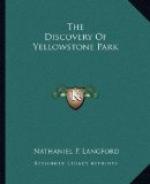Captain William Clark, of the famous Lewis and Clark expedition, dropped the final e from the word cowse, spelling it c-o-w-s. Unless this error is noticed by the reader, he will not understand what Captain Clark meant when he said that members of his party were searching for the cows.]
[Footnote T: Lieutenant Doane, in his official report to the War Department, says, concerning this episode:
“Washburn and Langford * * * became entangled in an immense swampy brimstone basin, abounding in sulphur springs. * * * Mr. Langford’s horse broke through several times, coming back plastered with the white substance and badly scalded.”]
[Footnote U: The location of this camp is what is now called the “Thumb” station on the stage route.]
[Footnote V: Analyses of the various specimens of mud taken from the springs in this locality, made on our return to Helena, gave the following results:
White Sediment. Lavender Sediment. Pink Sediment.
Silica......... 42.2 Silica ........ 28.2 Silica ........ 32.6
Magnesia....... 33.4 Alumina........ 58.6 Alumina........ 52.4
Lime........... 17.8 Boracic acid.... 3.2 Oxide of calcium 8.3
Alkalis......... 6.6 Oxide of iron... 0.6 Soda and potassa 4.2
------ Oxide of calcium 4.2 Water and loss.. 2.5
100.0 Water and loss.. 5.2 ----- ----- 100.0 100.0
These analyses were made by Professor Augustus Steitz, assayer of the First National Bank of Helena, Mont.]
[Footnote W: On our return home, finding that no tidings of Mr. Everts had been received, Jack Baronette and George A. Prichett, two experienced trappers and old mountaineers, were provided with thirty days’ provisions and dispatched in search of him, and by them Mr. Everts was found on October 16th, after wandering in the forest for thirty-seven days from the time he was lost. From the letter of Mr. Prichett addressed to Mr. Gillette, myself and others, I quote: “We found him on the 16th inst. on the summit of the first big mountain beyond Warm Spring creek, about seventy-five miles from Fort Ellis. He says he subsisted all this time on one snow bird, two small minnows and the wing of a bird which he found and mashed between two stones, and made some broth of in a yeast powder can. This was all, with the exception of thistle roots, he had subsisted on.”
The narrative of Mr. Everts, of his thirty-seven days’ sojourn in the wilderness (published in Scribner’s Magazine for November, 1871, and in volume V. of the Montana Historical Society publications), furnishes a chapter in the history of human endurance, exposure, and escape, almost as incredible as it is painfully instructive and entertaining.]
[Footnote X: Our general line of travel from the southwest estuary of the lake (Thumb) to the Firehole river was about one mile south of the present stage route. The tourist who to-day makes the rapid and comfortable tour of the park by stage, looking south from Shoshone Point, may catch a glimpse of a portion of the prostrate forest through and over which we struggled, and thus form some idea of the difficulties which beset us on our journey from the lake to the Firehole river.]




